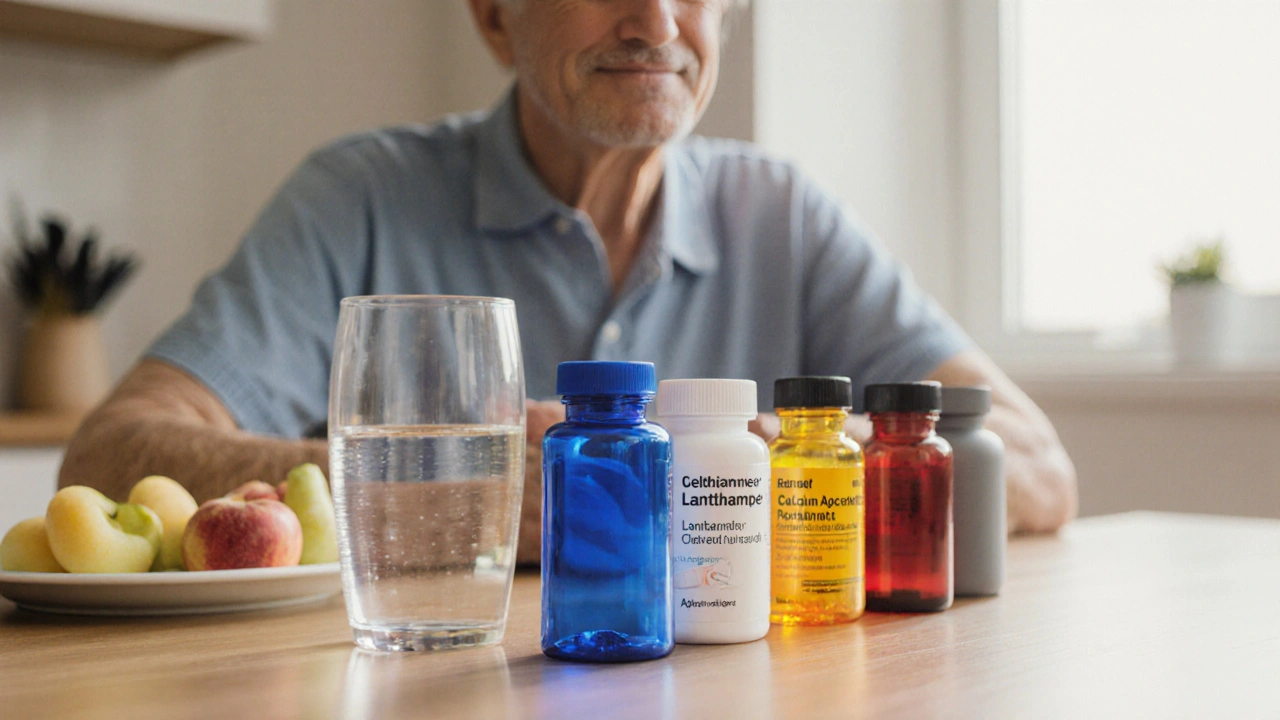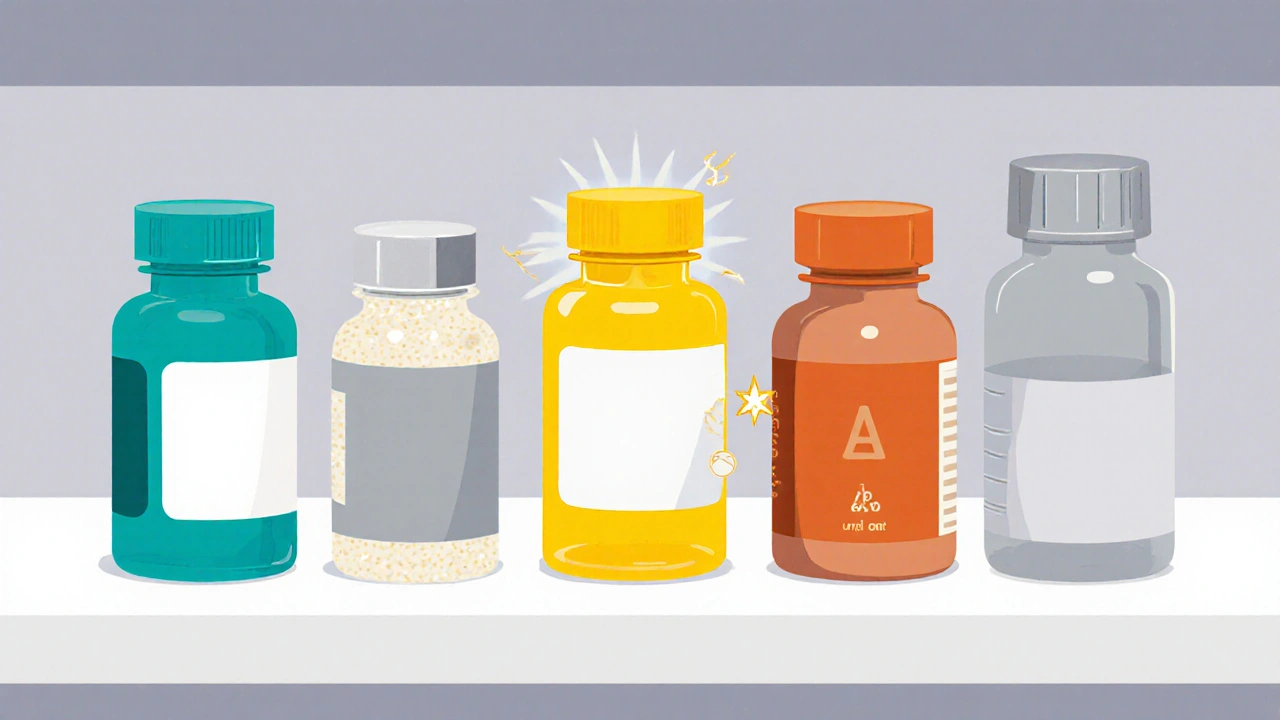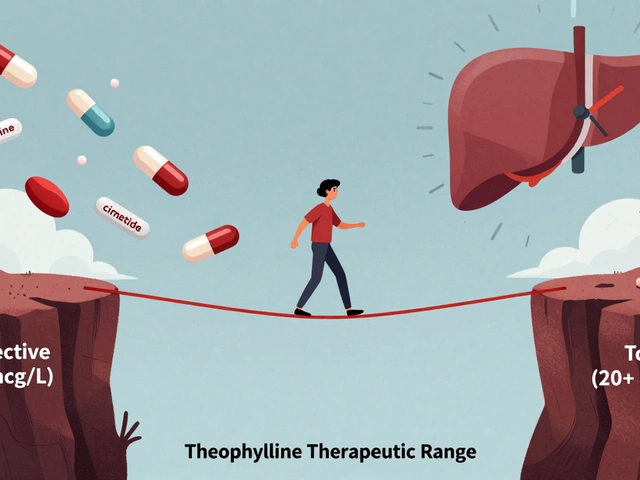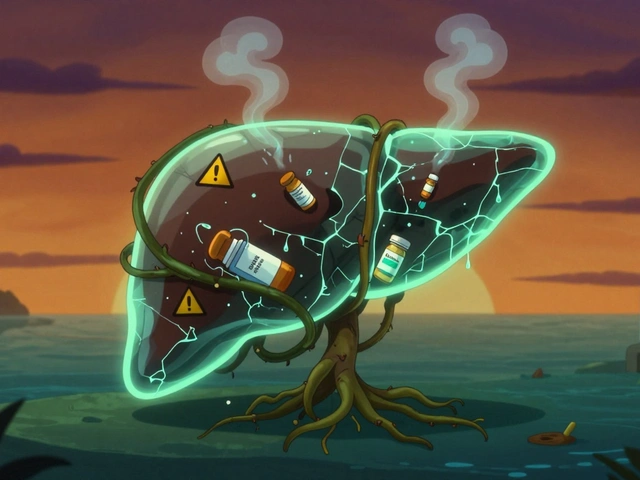
Phosphate Binder Selector
Recommended Binder
Binder Comparison Table
| Binder | Active Ingredient | Calcium Load | Key Extra Benefits | Monthly Cost (AU$) |
|---|---|---|---|---|
| Renagel (Sevelamer) | Sevelamer carbonate | None | Lowers LDL cholesterol | ≈ $180–$240 |
| Lanthanum Carbonate | Lanthanum carbonate | None | Low pill burden | ≈ $250–$300 |
| Calcium Acetate | Calcium acetate | High | Inexpensive | ≈ $30–$50 |
| Calcium Carbonate | Calcium carbonate | High | Very low cost | ≈ $20–$35 |
| Ferric Citrate | Ferric citrate | None | Provides iron; helps anemia | ≈ $150–$200 |
| Aluminum Hydroxide | Aluminum hydroxide | None | Very cheap | ≈ $15–$25 |
People with chronic kidney disease (CKD) on dialysis often struggle with high phosphate levels, a condition known as hyperphosphatemia. Managing those levels isn’t just about diet; the right phosphate binder can make a huge difference in quality of life and long‑term outcomes. This guide breaks down Renagel (the brand name for sevelamer) and compares it side‑by‑side with the most common alternatives, helping you decide which binder fits your health goals, lifestyle, and budget.
Key Takeaways
- Renagel is a non‑calcium, polymer‑based binder that also lowers LDL cholesterol.
- Calcium‑based binders (calcium acetate, calcium carbonate) are inexpensive but may raise calcium load.
- Lanthanum carbonate offers potent binding with low tablet count but is pricier.
- Ferric citrate adds an iron supplement benefit, useful for anemia‑prone patients.
- Aluminum hydroxide is effective but limited by toxicity concerns.
Decision Criteria When Choosing a Phosphate Binder
Before diving into individual products, it helps to weigh the factors that typically matter most to patients and clinicians:
- Efficacy: How well does the binder reduce serum phosphate?
- Calcium Load: Does the binder add extra calcium, potentially worsening vascular calcification?
- Side‑Effect Profile: GI upset, metabolic issues, or long‑term toxicity.
- Cost & Insurance Coverage: Out‑of‑pocket expense and formulary status.
- Pill Burden: Number of tablets needed daily and size of tablets.
- Additional Benefits: LDL‑cholesterol reduction, iron supplementation, or other metabolic effects.
Side‑by‑Side Comparison
| Binder | Active Ingredient | Typical Daily Dose | Calcium Load | Key Extra Benefits | Common Side Effects | Approx. Monthly Cost (AU$) |
|---|---|---|---|---|---|---|
| Renagel (Sevelamer) | Sevelamer carbonate | 800mg-2,400mg, 3-9 tablets | None | Lowers LDL‑cholesterol | GI upset, constipation | ≈$180-$240 |
| Lanthanum Carbonate | Lanthanum carbonate | 750mg-1,500mg, 2-4 tablets | None | Low pill burden | Nausea, dyspepsia | ≈$250-$300 |
| Calcium Acetate | Calcium acetate | 667mg-1,333mg, 2-4 tablets | High (adds calcium) | Inexpensive | Hypercalcemia, constipation | ≈$30-$50 |
| Calcium Carbonate | Calcium carbonate | 500mg-1,000mg, 2-4 tablets | High (adds calcium) | Very low cost | Hypercalcemia, constipation | ≈$20-$35 |
| Ferric Citrate | Ferric citrate | 1,000mg-3,000mg, 2-6 tablets | None | Provides iron; helps anemia | GI upset, dark stools | ≈$150-$200 |
| Aluminum Hydroxide | Aluminum hydroxide | 500mg-1,000mg, 3-6 tablets | None | Very cheap | Aluminum toxicity if used long‑term | ≈$15-$25 |
Renagel (Sevelamer): In‑Depth Look
Renagel is a polymeric phosphate binder that works by binding dietary phosphate in the gut without adding calcium. Because it contains no calcium, it’s a favorite for patients at risk of vascular calcification. Its secondary effect-lowering LDL‑cholesterol-offers an added cardiovascular advantage, especially important for the CKD population. Key points:
- Efficacy: Reduces serum phosphate by 0.6-0.9mg/dL on average.
- Side effects: Constipation is the most common; dose adjustments or a stool softener often help.
- Cost: Higher than calcium‑based options, but many Australian health plans cover a portion.
- Use case: Ideal for patients with high calcium‑phosphate product or those needing extra lipid control.

Lanthanum Carbonate: Strong Binding with Fewer Pills
Lanthanum carbonate binds phosphate similarly to sevelamer but has a much smaller tablet size. It’s often prescribed when pill burden becomes an issue. However, the price tag is steeper, and concerns about rare lanthanum accumulation in the brain remain under investigation.
- Efficacy: Comparable to sevelamer; can lower phosphate by up to 1.0mg/dL.
- Side effects: Nausea and dyspepsia, usually mild.
- Best for: Patients who struggle with taking 6‑9 tablets daily and can afford a higher cost.
Calcium‑Based Binders: Acetate and Carbonate
Both calcium acetate and calcium carbonate are the most budget‑friendly options. They add calcium to the regimen, which can be beneficial for those with low calcium levels but risky for patients prone to calcification.
- Efficacy: Slightly lower than sevelamer; typically reduces phosphate by 0.4-0.7mg/dL.
- Side effects: Hypercalcemia, constipation, and occasional gastric upset.
- Cost: Cheapest category, frequently fully subsidized in Australian PBS.
- Best for: Patients on low‑calcium diets who need an inexpensive solution.
Ferric Citrate: The Iron‑Boosting Binder
Ferric citrate offers dual action-phosphate binding and iron supplementation. For CKD patients with anemia, this can reduce the need for separate iron injections. However, the iron load can cause dark stools and occasional GI irritation.
- Efficacy: Comparable to sevelamer in phosphate reduction.
- Side effects: Constipation, black stools, occasional nausea.
- Best for: Anemic dialysis patients who want to cut down on IV iron.
Aluminum Hydroxide: Effective but Limited
Aluminum hydroxide was once a first‑line binder because it’s cheap and potent. Modern practice limits its use due to the risk of aluminum toxicity, especially in patients on long‑term dialysis. Use is typically short‑term or as a bridge while switching to another binder.
- Efficacy: Very high; can drop phosphate by >1mg/dL.
- Side effects: Risk of encephalopathy, bone disease with chronic use.
- Best for: Short‑term control when other binders are unavailable.

Choosing the Right Binder: A Quick Decision Tree
- Do you need to avoid extra calcium?
Yes → Consider Renagel, Lanthanum carbonate, Ferric citrate, or Aluminum hydroxide.
No → Calcium acetate or calcium carbonate may work. - Is pill burden a concern?
Yes → Lanthanum carbonate (low pill count) or Ferric citrate (moderate).
No → Renagel (higher tablet count) is acceptable. - Do you have anemia requiring iron?
Yes → Ferric citrate gives iron as a bonus.
No → Other binders avoid excess iron. - Is cost the primary driver?
Yes → Calcium acetate/carbonate or Aluminum hydroxide (if short‑term).
No → Renagel or Lanthanum for better safety profile.
Practical Checklist for Patients and Clinicians
- Confirm serum phosphate target (typically 1.13-1.78mg/dL for dialysis patients).
- Review current calcium‑phosphate product and any cardiovascular risk factors.
- Discuss insurance coverage and out‑of‑pocket budget.
- Assess pill burden tolerance and swallowing ability.
- Check for co‑existing anemia or dyslipidemia.
- Start with a low dose, titrate every 2-4 weeks based on labs.
- Monitor for side effects: constipation (Renagel), nausea (Lanthanum), hypercalcemia (calcium binders), iron overload (Ferric citrate), aluminum levels (Aluminum hydroxide).
What to Do If Your Phosphate Levels Remain High
Even with the right binder, some patients struggle to hit target phosphate. Here’s a troubleshooting flow:
- Re‑evaluate dietary phosphate intake-educate on hidden sources (processed foods, sodas).
- Check adherence: is the patient missing doses due to taste or size?
- Consider combination therapy: a low‑dose calcium binder plus a non‑calcium binder.
- Switch to a binder with a stronger binding capacity (e.g., from Renagel to Lanthanum).
- Review dialysis adequacy-insufficient dialysis can keep phosphate high regardless of binder.
Frequently Asked Questions
Can I take Renagel and calcium carbonate together?
Yes, you can combine a non‑calcium binder like Renagel with a small dose of calcium carbonate if you need extra calcium. However, keep the total calcium load below the recommended limit to avoid vascular calcification.
Why does Renagel lower LDL cholesterol?
Sevelamer has a positively charged polymer that binds bile acids in the gut, reducing their re‑absorption. The body then pulls more cholesterol from the blood to make new bile acids, lowering LDL levels.
Is aluminum hydroxide safe for long‑term use?
Generally no. Chronic use can lead to aluminum accumulation, causing bone disease and neuro‑cognitive issues. It’s best reserved for short‑term bridging.
Which binder is best for patients on a low‑sodium diet?
All binders are low in sodium, but sevelamer (Renagel) and lanthanum carbonate have no added sodium salts, making them safe choices for sodium‑restricted diets.
How often should I have blood tests after switching binders?
Check serum phosphate, calcium, and PTH every 2-4 weeks during the titration phase. Once stable, monthly monitoring is sufficient.
Next Steps
If you’re a patient, bring this comparison to your nephrologist or renal dietitian. Ask for a trial of the binder that aligns with your lab results, pill‑taking ability, and budget. If you’re a clinician, use the decision tree and checklist to personalize binder selection, and keep an eye on emerging data-especially around long‑term safety of lanthanum and ferric citrate.
Remember, the right phosphate binder is only one piece of the puzzle. Pair it with dietary counseling, optimal dialysis, and regular lab monitoring for the best outcomes.






10 Comments
Oh, look at the dazzling array of pricey binders, each promising to cure the world while silently demanding your wallet's surrender. Of course, the non‑calcium options are heralded as saints, yet you’ll still be choking on the cost. If you ever cared about your health beyond the next bill, you’d actually read the fine print before choosing.
/p>Wow! Who even needs calcium when you can have a pill mountain that looks like a Lego set!! Sevelamer? More like Seve‑LAME‑R! My stomach’s doing somersaults, but hey, at least my LDL is lower… kind of?
/p>The pharma giants are definitely hiding the truth: they want you strapped to a budget‑draining regimen while they profit off your dialysis. And let’s not forget, every time you swallow another binder, you’re letting the global elite tighten their grip. Proud to support the American way of fighting back against this medical tyranny.
/p>Indeed, the pharmacoeconomic landscape is replete with variables-cost‑effectiveness ratios, adherence metrics, and a plethora of outcome‑based endpoints; however, one must also consider the bioavailability indices, which are often under‑reported in phase‑III trials.
/p>Renagel is overrated.
/p>i think its worth a try if you dont mind the size. the trade‑off between cost and cholesterol benefit is kinda cool.
/p>One must approach the selection of a phosphate binder with a rigorous, evidence‑based mindset, acknowledging both the biochemical efficacy and the socioeconomic implications. The literature consistently demonstrates that non‑calcium binders mitigate vascular calcification risk, yet their affordability remains a barrier for many. A judicious balance between clinical benefit and patient accessibility is essential for optimal outcomes.
/p>Ah, the noble pursuit of the perfect binder-truly a quest fit for the annals of modern medicine, if one enjoys endless paperwork and insurance negotiations.
/p>Nothing says true patriotism like refusing cheap calcium binders that could wreck your arteries. Go big or go home-choose the binder that keeps America’s kidneys strong.
/p>While your enthusiasm is noted, please remember that “its” should be “it’s” in this context. 😊 Let’s keep the grammar as pristine as our labs.
/p>